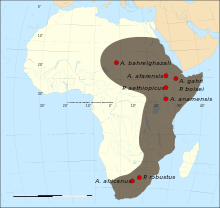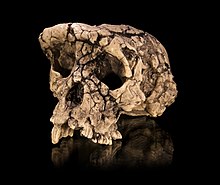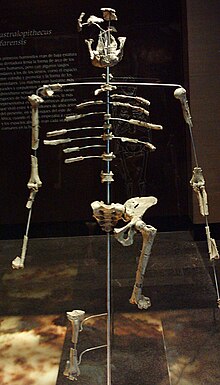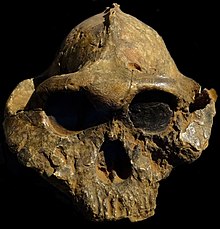Early Hominid Fossils: Review of Evidence
Overview of Human Evolutionary Origin
[edit | edit source]The fossil record provides little information about the evolution of the human lineage during the Late Miocene, from 10 million to 5 million years ago. Around 10 million years ago, several species of large-bodied hominids that bore some resemblance to modern orangutans lived in Africa and Asia. About this time, the world began to cool; grassland and savanna habitats spread; and forests began to shrink in much of the tropics.
The creatures that occupied tropical forests declined in variety and abundance, while those that lived in the open grasslands thrived. We know that at least one ape species survived the environmental changes that occurred during the Late Miocene, because molecular genetics tells us that humans, gorillas, bonobos and chimpanzees are all descended from a common ancestor that lived sometime between 7 million and 5 million years ago. Unfortunately, the fossil record for the Late Miocene tells us little about the creature that linked the forest apes to modern hominids.
Beginning about 5 million years ago, hominids begin to appear in the fossil record. These early hominids were different from any of the Miocene apes in one important way: they walked upright (as we do). Otherwise, the earliest hominids were probably not much different from modern apes in their behavior or appearance.
Between 4 million and 2 million years ago, the hominid lineage diversified, creating a community of several hominid species that ranged through eastern and southern Africa. Among the members of this community, two distinct patterns of adaptation emerged:
- One group of creatures (Australopithecus, Ardipithecus, Paranthropus) evolved large molars that enhanced their ability to process coarse plant foods;
- The second group, constituted of members of our own genus Homo (as well as Australopithecus garhi) evolved larger brains, manufactured and used stone tools, and relied more on meat than the Australopithecines did.
Hominid Species
[edit | edit source]
| Species | Type | Specimen | Named by |
| Sahelanthropus | tchadensis "Toumai" | TM 266-01-060-1 | Brunet et al. 2002 |
| Orrorin | tugenensis | BAR 1000'00 | Senut et al. 2001 |
| Ardipithecus | ramidus | ARA-VP 6/1 | White et al. 1994 |
| Australopithecus | anamensis | KP 29281 | M. Leakey et al. 1995 |
| Australopithecus | afarensis | LH 4 | Johanson et al. 1978 |
| Australopithecus | bahrelghazali | KT 12/H1 | Brunet et al. 1996 |
| Kenyanthropus | platyops | KNM-WT 40000 | M. Leakey et al. 2001 |
| Australopithecus | garhi | BOU-VP-12/130 | Asfaw et al. 1999 |
| Australopithecus | africanus | Taung | Dart 1925 |
| Australopithecus | aethiopicus | Omo 18 | Arambourg & Coppens 1968 |
| Paranthropus | robustus | TM 1517 | Broom 1938 |
| Paranthropus | boisei | OH 5 | L. Leakey 1959 |
| Homo | habilis | OH 7 | L. Leakey et al. 1964 |
Sahelanthropus tchadensis ("Toumai")
[edit | edit source]
- Named in July 2002 from fossils discovered in Chad.
- Oldest known hominid or near-hominid species (6-7 million years ago).
- Discovery of nearly complete cranium and number of fragmentary lower jaws and teeth:
- Skull has very small brain size (ca. 350 cc), considered as primitive apelike feature;
- Yet, other features are characteristic of later hominids: short and relatively flat face; canines are smaller and shorter; tooth enamel is slightly thicker (suggesting a diet with less fruit).
- This mixture of features, along with fact that it comes from around the time when hominids are thought to have diverged from chimpanzees, suggests it is close to the common ancestor of humans and chimpanzees.
- Foramen magnum is oval (not rounded as in chimps) suggesting upright walking position.
Orrorin tugenensis
[edit | edit source]- Named in July 2001; fossils discovered in western Kenya.
- Deposits dated to about 6 million years ago.
- Fossils include fragmentary arm and thigh bones, lower jaws, and teeth:
- Limb bones are about 1.5 times larger than those of Lucy, and suggest that it was about the size of a female chimpanzee.
- Its finders claimed that Orrorin was a human ancestor adapted to both bipedality and tree climbing, and that the australopithecines are an extinct offshoot.
Ardipithecus ramidus
[edit | edit source]
- Recent discovery announced in Sept. 1994.
- Dated 4.4 million years ago.
- Most remains are skull fragments.
- Indirect evidence suggests that it was possibly bipedal, and that some individuals were about 122 cm (4'0") tall;
- Teeth are intermediate between those of earlier apes and Austalopithecus afarensis.
Australopithecus anamensis
[edit | edit source]- Named in August 1995 from fossils from Kanapoi and Allia Bay in Kenya.
- Dated between 4.2 and 3.9 million years ago.
- Fossils show mixture of primitive features in the skull, and advanced features in the body:
- Teeth and jaws are very similar to those of older fossil apes;
- Partial tibia (inner calf bone) is strong evidence of bipedality, and lower humerus (the upper arm bone) is extremely humanlike.
Australopithecus afarensis
[edit | edit source]
- Existed between 3.9 and 3.0 million years ago.
- A. afarensis had an apelike face with a low forehead, a bony ridge over the eyes, a flat nose, and no chin. They had protruding jaws with large back teeth.
- Cranial capacity: 375 to 550 cc. Skull is similar to chimpanzee, except for more human-like teeth. Canine teeth are much smaller than modern apes, but larger and more pointed than humans, and shape of the jaw is between rectangular shape of apes and parabolic shape of humans.
- Pelvis and leg bones far more closely resemble those of modern humans, and leave no doubt that they were bipedal.
- Bones show that they were physically very strong.
- Females were substantially smaller than males, a condition known as sexual dimorphism. Height varied between about 107 cm (3'6") and 152 cm (5'0").
- Finger and toe bones are curved and proportionally longer than in humans, but hands are similar to humans in most other details.
Kenyanthropus platyops ("flat-faced man of Kenya")
[edit | edit source]
- Named in 2001 from partial skull found in Kenya.
- Dated to about 3.5 million years ago.
- Fossils show unusual mixture of features: size of skull is similar to A. afarensis and A. africanus, and has a large, flat face and small teeth.
Australopithecus garhi
[edit | edit source]- A. garhi existed around 2.5 Myrs.
- It has an apelike face in the lower part, with a protruding jaw resembling that of A. afarensis. The large size of the palate and teeth suggests that it is a male, with a small braincase of about 450 cc.
- It is like no other hominid species and is clearly not a robust form. In a few dental traits, such as the shape of the premolar and the size ratio of the canine teeth to the molars, A. garhi resembles specimens of early Homo. But its molars are huge, even larger than the A. robustus average.
- Among skeletal finds recovered, femur (upper leg bone) is relatively long, like that of modern humans. But forearm is long too, a condition found in apes and other australopithecines but not in humans.
Australopithecus africanus
[edit | edit source]- First identified in 1924 by Raymond Dart, an Australian anatomist living in South Africa.
- A. africanus existed between 3 and 2 million years ago.
- Similar to A. afarensis, and was also bipedal, but body size was slightly greater.
- Brain size may also have been slightly larger, ranging between 420 and 500 cc. This is a little larger than chimp brains (despite a similar body size).
- Back teeth were a little bigger than in A. afarensis. Although the teeth and jaws of A. africanus are much larger than those of humans, they are far more similar to human teeth than to those of apes. The shape of the jaw is now fully parabolic, like that of humans, and the size of the canine teeth is further reduced compared to A. afarensis.
NOTE: Australopithecus afarensis and A. africanus are known as gracile australopithecines, because of their relatively lighter build, especially in the skull and teeth. (Gracile means "slender", and in paleoanthropology is used as an antonym to "robust"). Despite the use of the word "gracile", these creatures were still more far more robust than modern humans.
Australopithecus aethiopicus
[edit | edit source]- A. aethiopicus existed between 2.6 and 2.3 million years ago.
- Species known mainly from one major specimen: the Black Skull (KNM-WT 17000) discovered at Lake Turkana.
- It may be ancestor of P. robustus and P. boisei, but it has a baffling mixture of primitive and advanced traits:
- Brain size is very small (410 cc) and parts of the skull (particularly the hind portions) are very primitive, most resembling A. afarensis;
- Other characteristics, like massiveness of face, jaws and largest sagittal crest in any known hominid, are more reminiscent of P. boisei.
Paranthropus boisei
[edit | edit source]
- P. boisei existed between 2.2 and 1.3 million years ago.
- Similar to P. robustus, but face and cheek teeth were even more massive, some molars being up to 2 cm across. Brain size is very similar to P. robustus, about 530 cc.
- A few experts consider P. boisei and P. robustus to be variants of the same species.
Paranthropus robustus
[edit | edit source]- P. robustus had a body similar to that of A. africanus, but a larger and more robust skull and teeth.
- It existed between 2 and 1.5 million years ago.
- The massive face is flat, with large brow ridges and no forehead. It has relatively small front teeth, but massive grinding teeth in a large lower jaw. Most specimens have sagittal crests.
- Its diet would have been mostly coarse, tough food that needed a lot of chewing.
- The average brain size is about 530 cc. Bones excavated with P. robustus skeletons indicate that they may have been used as digging tools.
Australopithecus aethiopicus, Paranthropus robustus and P. boisei are known as robust australopithecines, because their skulls in particular are more heavily built.
Homo habilis
[edit | edit source]
- H. habilis ("handy man")
- H. habilis existed between 2.4 and 1.5 million years ago.
- It is very similar to australopithecines in many ways. The face is still primitive, but it projects less than in A. africanus. The back teeth are smaller, but still considerably larger than in modern humans.
- The average brain size, at 650 cc, larger than in australopithecines. Brain size varies between 500 and 800 cc, overlapping the australopithecines at the low end and H. erectus at the high end. The brain shape is also more humanlike.
- H. habilis is thought to have been about 127 cm (5'0") tall, and about 45 kg (100 lb) in weight, although females may have been smaller.
- Because of important morphological variation among the fossils, H. habilis has been a controversial species. Some scientists have not accepted it, believing that all H. habilis specimens should be assigned to either the australopithecines or Homo erectus. Many now believe that H. habilis combines specimens from at least two different Homo species: small-brained less-robust individuals (H. habilis) and large-brained, more robust ones (H. rudolfensis). Presently, not enough is known about these creatures to resolve this debate.